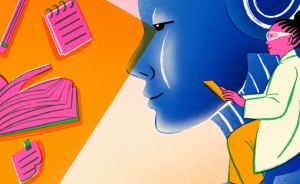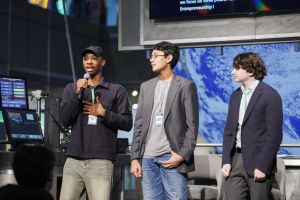Evan is the Lead Software Engineer at MIT App Inventor. He aims to help App Inventor users realize the full potential of their app ideas through the development of new components and features to aid in collaboration, rich data collection and visualization, and efficiency. His research interests include real-time collaboration, Internet of Things, and applications of artificial intelligence to facilitate mobile app development through projects like MIT Aptly. Evan also oversees the development of the MIT Punya project to extend App Inventor with semantic capabilities for healthcare and humanitarian causes. He holds a Ph.D. in Computer Science from Rensselaer Polytechnic Institute where he studied techniques to reduce power consumption of reasoning algorithms on mobile phones.
For starters, what exactly is the Punya project?
MIT Punya is a project born out of the aftermath of the earthquakes in Haiti in 2010, which also saw the rise of crowdsourcing platforms like Ushahidi. The project was started by CSAIL Principal Research Scientist Lalana Kagal and is aimed at increasing the accessibility of a variety of tools in a reusable, extensible way to the broader public to address issues of resource optimization, data sharing, and remixability to address humanitarian and health care related issues. The Punya platform builds on MIT App Inventor, the project of which I am the lead software engineer, and adds integration with Linked Data and Semantic Web to empower people to build apps that can easily share data between applications using a suite of structured representations (called ontologies), with the hope of building a critical mass of many such open apps in a breadth of domains.
You were recently a part of the MIT Generative AI Week. What impact will generative AI have on education and the future of work?
At MIT App Inventor, I incubated the Aptly project, which combines App Inventor with the power of generative artificial intelligence (generative AI). A number of staff and students have contributed to that project and it was this effort that I presented at MIT Generative AI week. During a panel that day, Prof. Abelson, the principal investigator for the App Inventor project, spoke about our mission of computational action and how generative AI can further that goal. Tools like Aptly, which allow people to give natural language instructions to build mobile apps. In fact, the large language models powering these tools allow you to build apps in any language, whether that is English, Italian, or Dutch (three I have tried so far). Our demonstration began with a motivation about food waste and how one might build an app to address it with an instruction “create me an app that will help me track the contents of my refrigerator.” We then built on the app with suggestions like “make the buttons in the app reflect their purpose,” “make the colors more color-blind friendly,” and “use generative AI to recommend recipes based on the current contents of my fridge.” Our hope is that anyone who sees a problem in their home, their community, or even the world at large can start to solve those problems by expressing a vision of their solution through a tool like Aptly. We even recently prototyped a version where you simply speak to your phone and it works to create and edit the app all in the palm of your hand.
What do you say to those with technophobia to ease their anxiety about AI’s seemingly sudden advancement?
I have given many workshops and demonstrations of AI tools we have built over the years, and I would say the most important thing to recognize is that the tool is doing the work but you are the creator. Recently the team ran a workshop for business executives in a class offered by the MIT Sloan School for Business. In the workshop, participants built a simple chat app in 30 minutes. However, at the end of the workshop as people are trying the app, it is not the AI that is coming up with the questions to ask. Each person in the room had their own questions to ask of the system. Asking questions is the real human element of this whole process–our innate curiosity as individuals and as a species are the real driving force behind AI. If you sit in front of ChatGPT, it is waiting for YOU to guide it. In many ways, I think that the “intelligence” of AI is a bit oversold since I am not sure that anything can be truly intelligent without an internal element of curiosity. As long as you continue to be curious about things you’ll likely remain in the driver’s seat when it comes to AI.
What are some of your favorite App Inventor projects that have had a positive effect on education or learning?
As the lead software engineer of App Inventor, I have had the opportunity to contribute or mentor projects that have directly expanded educational capabilities of the platform. One of my first major contributions to the project was the Map and related components. This has led to a number of curricula modules like the 50 States Capital quiz in the Mobile CSP curriculum (a College Board approved CSP curriculum built around MIT App Inventor). There are also the Hong Kong Tour Guide (CoolThink) and Boston Tour Guide (MIT) units used at the 6th grade level. We also have a wealth of modules around different AI concepts, particularly our Personal Image Classifier extension (used in our PICaboo tutorial), where students get the opportunity to train their own AI classifier and build an app with which they play peek-a-boo. It’s a great way for teachers to pull back the curtain of AI and let students see when things work, and probably more importantly, when they don’t. Lastly, we have a version of App Inventor that integrates with Amazon Alexa where students learn to build their own Alexa skills to better understand how voice assistants work. Over 40k students have used this platform to date to experience the thrill of making a virtual assistant accept and respond to their commands. Teachers and parents can sign up to use this platform in the US and UK here.
What is your favorite thing about being at MIT?
The best thing about working at MIT is the breadth of experiences and ingenuity that my colleagues bring to any problem. Some are former educators, others have worked in industry, or even other countries. The undergraduate and graduate students (UROPs, M.Eng, and Ph.D.) come from all over the world and all walks of life, but all are interested in advancing how people think about technology and their power over it by using App Inventor as a tool to produce new ideas rather than simply consume ideas produced by others. We have even had students come onto the project who used it in school or organized coding camps around App Inventor, so it is very rewarding to see how they can take the skills they develop and reflect that back into the program for the benefit of others.




